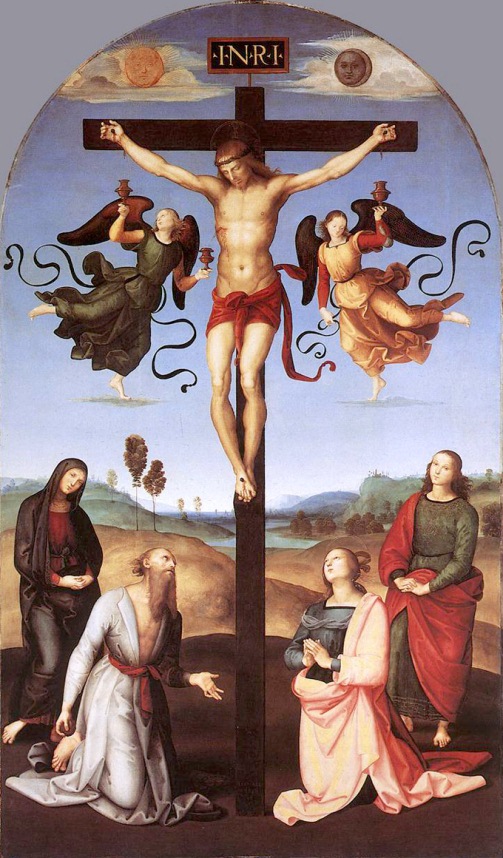Continuing our series looking at great paintings housed in London’s National Gallery…
The National Gallery has thirteen Raphaels (if you include the dubious Madonna of the Pinks, recently ‘saved for the nation’). The one that always draws me towards it is the Mond Crucifixion (in Room 8). There’s something about the sheer daunting perfection of mature Raphael that I find faintly alienating, whereas his early work has an inviting freshness and openness.
The Mond Crucifixion is very early, painted under the influence of his master, Perugino – those elegant angels on their tiny clouds could indeed be straight out of one of the National’s Peruginos, The Virgin and Child With Saints Jerome and Francis. But the beauty of the young Raphael’s painting of, in particular, the faces and figures at the foot of the cross, and the glorious, softly lit Umbrian landscape that opens up in the background, suggest that he had already learned all his master had to teach him.
It is the sweetest, serenest crucifixion, with not a hint of anguish – even Christ’s blood is no more than a discreet jet of claret into a waiting chalice. How could there be anything but peace and love under a sky of that heavenly blue?









what a blue! that blue is that magic darkling blue of night falling. an amazing picture
Yes, it is indeed splendid, but, as maybe you suggest, perhaps a little too perfect. I rahter like the treatments of such themes by El Greco and Murillo, casting the local butcher, whelk-stall-holder and street urchin in the holy roles.
Gadjo Dilo has a point. Put slightly differently, sometimes it’s just too much to try to engage with a Saviour who can manage to be tortured to death under a sky as magnificently tranquil as that one. But for moments like that, there’s always, for instance, this. Or indeed this.
One might also pause to ponder – missing as one does so James Beck – whether the sky always looked like that, or whether the surviving shadows and shapings still visible in the figures didn’t find their match in the air above, before the National Gallery’s notably unsqueamish ‘restorers’ got to work.
No matter, though – the Mond Crucifixion remains a truly beautiful, haunting picture, and Nige’s post does justice to one of its most beautiful features.
Interesting coments, Barendina – my word, that Tintoretto really does have a different take on the crucifixion, doesn’t he. I’m sure there’s room for both types in the world, and looking again at the Raphael Nige has given us I’m getting more out of it. I’m guessing that the angle of each hand and the placement of each hand means something, rather as e.g. J. S. Bach’s use of numerological motifs means something.